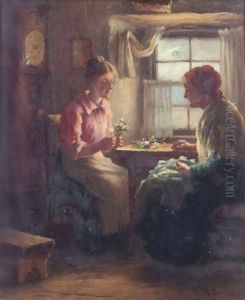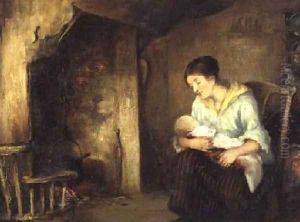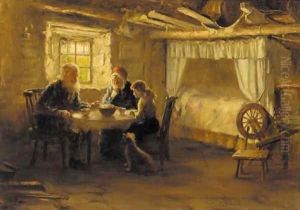Thomas McEwan Paintings
Thomas McEwan was a Scottish painter and artist, born in 1846 in Glasgow, Scotland, and died in 1914. His life and career spanned the Victorian era, a period characterized by industrial progress, social change, and a flourishing art scene in Britain. McEwan was part of this vibrant art world, contributing significantly with his works, primarily focusing on landscapes and genre scenes that captured the essence of Scottish life and scenery.
McEwan's early life was rooted in Glasgow, a city undergoing rapid transformation during his youth, which likely influenced his interest in depicting both the natural beauty of Scotland and the social dynamics of its people. He received his art education at the Glasgow School of Art, an institution pivotal in developing the talents of many Scottish artists who would go on to achieve national and international acclaim. McEwan's education and early exposure to the art scene in Glasgow would have provided him with the technical skills and artistic sensibilities that defined his career.
Throughout his career, McEwan exhibited a profound ability to capture the mood and atmosphere of his subjects, whether it was the serene Scottish Highlands or the bustling streets of Glasgow. His works were characterized by their rich color palette, attention to detail, and emotive quality, traits that made his paintings both popular and critically acclaimed during his lifetime. McEwan was an active participant in the art community, contributing to various exhibitions and being involved with art societies, which helped him to establish a significant reputation as an artist.
Despite his contributions and the quality of his work, Thomas McEwan remains a somewhat obscure figure in the art world today, overshadowed by his contemporaries and the next generation of artists who emerged from the Glasgow School. However, his paintings continue to be appreciated by art historians and collectors for their beauty and historical value, offering insights into the cultural and natural landscapes of 19th-century Scotland.
McEwan's death in 1914 marked the end of a career that had spanned several decades, during which he witnessed and documented through his art the profound changes occurring in Scotland and the wider British society. His legacy, though not as widely recognized as some of his peers, remains important for understanding the richness and diversity of Victorian-era Scottish art.




